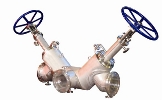Guichon fertigt Sonderarmaturen zur Herstellung von DTM/TiO2 – Titandioxid
Kolbenventile, Ablassventile, Mehrwegeventil, Kugelhähne
| FAQ |
| 3-Wege Kegelventil Type : 612 DN 150 x 100 x 100 bis DN 300 x 250 x 250 PN 150 – geschweisste Ausführung mit Heizmantel, Faltenbalgabdichtung Edelstahl (1.4404/1.4571, usw.) |

|
| 2-Teiliger Kugelhahn Typ : 305 DN 25 bis 100 PN 16 bis 320 – Einbau zwischen Flansche Nickellegierungen und Sonderlegierungen (Zirkon. 702) |

FAQ - Titandioxid-TiO2Titandioxid-TiO2 – Anwendungen von Titandioxid-TiO2 :Titanium dioxide (TiO2) is a simple inorganic compound produced as a pure white powder. More than 50 % of the titanium dioxide is used in paints, varnishes and lacquer. It also is used in coatings, paper and plastics industries with total worldwide sales of around 4.5 million tons per year. Posted in: FAQ - Titandioxid-TiO2 Titandioxid-TiO2 – Herstellungsprozess von Titandioxid-TiO2 :Manufacture takes place by either the sulfate process or the chloride process and the main raw materials include ilmenite (FeO/TiO2), naturally occurring rutile, or titanium slag. In essence the process converts the impure TiO2 feedstock into an easy to purify intermediate, separates out the impurities then converts back to pure TiO2 (see figure 1).
Because of significant environmental and cost issues associated with the sulfate process, most new manufacturing plants are based on the chloride process. The quantity of waste materials is thus reduced compared to the older sulfate process. However, the chloride process is more difficult to operate. The extreme corrosiveness of the high temperature chlorine (900 – 1000°C) employed in the process contributes to the difficulty. Posted in: FAQ - Titandioxid-TiO2 Titandioxid-TiO2 – Empfohlene Ventile :For this kind of acidic and corrosive media, Tantaline valves offer a corrosion resistance beyond nickel alloys (Hastelloy), titanium (Ti) and zirconium (Zr). Posted in: FAQ - Titandioxid-TiO2 |










